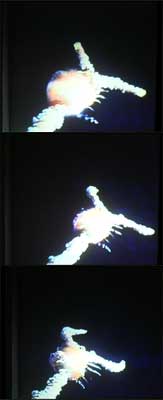joint projects
On Heaven As It Is On Earth

'In literally blowing apart the myth of technology as champion, the Challenger explosion was the most appropriately named event of our time. Indeed, in this heroic loss (or loss of heroism) it becomes clear that our compulsion for investigation arises from a fundamental insecurity'.
Jeremy Miller, Catalogue for the Institute of Cultural Anxiety, ICA, London
On January 28th 1986, the Challenger space shuttle lifted off from Huston.
It was a routine flight with the only remarkable aspect being that for the first time a civilian was serving as the flight team. One minute and fifteen seconds into the flight an explosion occured due to a fuel leakage caused by a corruption of the 'O' rings in the fuel tank. The explosion was massive and beamed instantaneously around the world. In the ensuing confusion and damage limitation, NASA claimed that all seven astronauts died instantly. However, it has recently been officially accepted that they had survived for roughly two minutes after the explosion. There has been atranscript of the last two minutes of radio contact circulating for years.
The transcript often breaks up, and runs from panic, to an attempted ditch landing, and finally the passing out of the first astronauts as one recites the Lord's prayer, until this too fades into static, then silence.
It could be a fake, but maybe this isn't important. Maybe what is important is that we will never know.
The short-lived mission is re-animated via a 35mm slide projector. Seven minutes of footage is condensed into eighty eight slides, with a complete rotation of the carousel lasting one minute and forty seconds. The narrative is analogue and linear. The viewer can go forward and backwards, reslicing the already edited narrative. Like the adored features of the VCR and DVD players, the viewers favourite moment can be frozen and repeated, constantly delaying and extending the inevitable.
The projector provides its own automated soundtrack, the mechanics of the roation amplified and feeding back. The rhythmic feedback loop is caused by the viewer activating the projector. At times the feedback begins to peak, and the viewer is forced to stop the rotation, pausing on a random slide as the sound recedes and the electrical network settles. In this sense, the viewer/operator is in charge of how far the want to push the machines, how close they wish to take the feedback to a critical mass or to an eventual blow-out.
In light of the astronauts 'extended survival' , the footage of the Challenger explosion can be seen as documentation of a macabre and spectacular demonstation of Schrodinger's cat theory. After the explosion, each frame is a possible end. The evidence, however, is contained, and the conclusion unratifiable. The frames point towards an uncertain and notional state inbetween life and death.